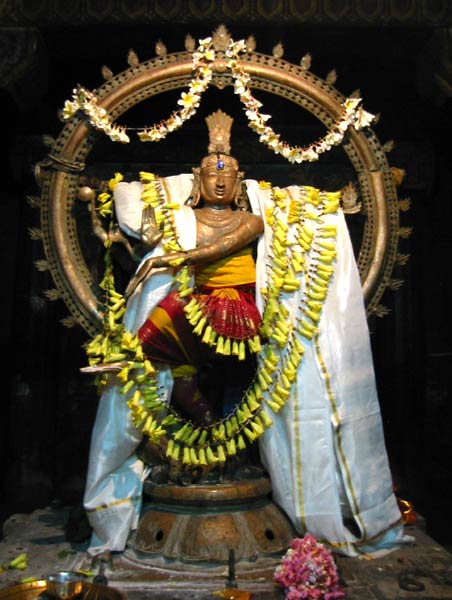 filled with the spirit of the deity they represent, others are bathed and dressed to invite the deity or saint to enter the image temporarily. On the right it is shown dressed as it would be when carried through the streets of a southern Indian city during a religious festival. For most of the year, an image such as this is kept in its own shrine in a large temple. Once a year during an elaborate puja, it is washed with sacred water, then with milk, yogurt, honey, sandalwood paste, and ashes before being dressed in ceremonial robes. It is lavishly adorned with garlands of flowers and may also be decorated with jewelry. Priests then invoke the spirit of the deity or saint depicted to enter the bronze. For the duration of the ceremony the image is thought to contain the divine being's presence. In an elaborate procession many sacred images are paraded through the streets accompanied by thousands of devotees. Hindus believe that even a glimpse of an image filled with the spirit of the god or saint facilitates a direct visual communication ( darshan ) with the deity, which will bring blessings to the worshiper.
filled with the spirit of the deity they represent, others are bathed and dressed to invite the deity or saint to enter the image temporarily. On the right it is shown dressed as it would be when carried through the streets of a southern Indian city during a religious festival. For most of the year, an image such as this is kept in its own shrine in a large temple. Once a year during an elaborate puja, it is washed with sacred water, then with milk, yogurt, honey, sandalwood paste, and ashes before being dressed in ceremonial robes. It is lavishly adorned with garlands of flowers and may also be decorated with jewelry. Priests then invoke the spirit of the deity or saint depicted to enter the bronze. For the duration of the ceremony the image is thought to contain the divine being's presence. In an elaborate procession many sacred images are paraded through the streets accompanied by thousands of devotees. Hindus believe that even a glimpse of an image filled with the spirit of the god or saint facilitates a direct visual communication ( darshan ) with the deity, which will bring blessings to the worshiper. Darshan is a reciprocal act between the worshiper and the deity. Not only does the devotee "see" the deity, but the deity is understood to "see" the worshiper. For this reason, Hindu images often have strikingly large eyes to facilitate this exchange of glances between devotee and deity.
